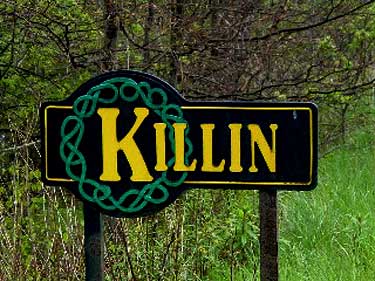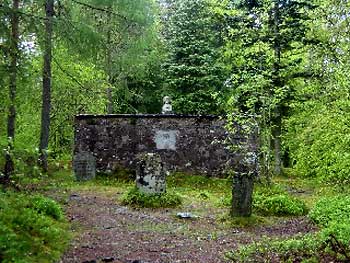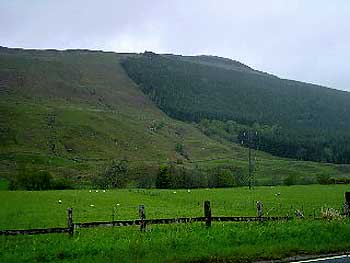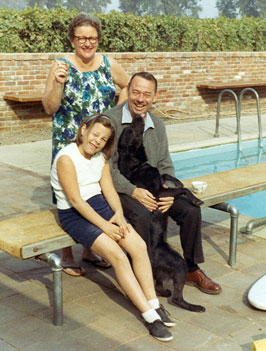About McNab Cattle Dogs
 In Scotland, hundreds of years ago the country was separated into areas or lands of the Clans. The McNab Clan Lands were located north of Glasgow in the Grampian Mountain range and the seat of the clan was in Killin. Though their lands were forfeited in 1306 when they formed an alliance with McDougall of Lorn to fight against Robert the Bruce a charter was issued to Gilbert McNab in 1336. In 1816, Archibald McNab succeeded as chief of the MacNab clan and inherited an insurmountable debt. By 1823, he fled to Canada and was granted land near the Ottawa River. The ancestral lands in Scotland were foreclosed upon and purchased by the Fourth Earl of Breadalbane. In 1949 Archibald Corrie McNab, 22nd chief purchased Kinnel house and 7000 acres of the original ancestral MacNab lands from the Breadalbane estate. The present MacNab-clan chief still resides there today. There are many spellings of the name. The original recorded is MacNab meaning " sons or children of the abbot" in 1124. As with many of the Scottish surnames it took on other mutations of the name and we see it spelled as McNab as for Alexander McNab the man who emigrated to Mendecino from a farm near Glasgow. {Photo top right: Sign just outside the Killin 'City' Border}
In Scotland, hundreds of years ago the country was separated into areas or lands of the Clans. The McNab Clan Lands were located north of Glasgow in the Grampian Mountain range and the seat of the clan was in Killin. Though their lands were forfeited in 1306 when they formed an alliance with McDougall of Lorn to fight against Robert the Bruce a charter was issued to Gilbert McNab in 1336. In 1816, Archibald McNab succeeded as chief of the MacNab clan and inherited an insurmountable debt. By 1823, he fled to Canada and was granted land near the Ottawa River. The ancestral lands in Scotland were foreclosed upon and purchased by the Fourth Earl of Breadalbane. In 1949 Archibald Corrie McNab, 22nd chief purchased Kinnel house and 7000 acres of the original ancestral MacNab lands from the Breadalbane estate. The present MacNab-clan chief still resides there today. There are many spellings of the name. The original recorded is MacNab meaning " sons or children of the abbot" in 1124. As with many of the Scottish surnames it took on other mutations of the name and we see it spelled as McNab as for Alexander McNab the man who emigrated to Mendecino from a farm near Glasgow. {Photo top right: Sign just outside the Killin 'City' Border}

Due to health reasons, Alexander left his home near Glasgow in 1868 to start new in California. He found that the land in Mendocino was very much like his homeland and there with his family raised sheep and his dogs. Alexander made many trips back to the Grampian Mountains of Scotland to replenish his breeding stock. The Grampian Mountains extend from the west coast of Scotland to the east coast north of Glasgow with the highest mountain at 3300 ft.
His first dog was Flora. He then later went back to Scotland and brought back Pete and Fred. By 1894 he also had Clyde, Help, Gyp, Tweed and Bessie. Alexander's son, John, who besides being a stockman was also a noted attorney inherited the McNab ranch and continued to import dogs from Scotland. He also started crossing them with dogs from the Basque Shepherds. {Photo left: The McNab Burial Site}
 I traveled to Scotland in 2003, to see the land he left and to visit with three of Scotland's top herdsmen and international sheepdog trial competitors. I had the pleasure of meeting David Shenna, Joch Welsh, and Johnny Wilson. Sheep farming and Border Collie breeding have been in their families for generations. Johnny won the 2003 International Sheep Dog Trial in Stranraer for the 3rd time. I gave them what history I knew of the McNab dog. One main question I had, was if there was ever a dog called a Fox Shepard as is sometimes mentioned in the McNab history. And they had never heard of a dog with that name! The Border Collie has been the only dog used for herding sheep. I personally think for the sake of Victorian embellishment they were called Scottish Collies in some of the McNab dog histories. Around the time Alexander brought his dogs over from Scotland they were recognizing the Border Collie as a breed. I realize there are many McNab breeders who emphasize on the Fox Shepard concept and breed McNab's for a small foxy look with black coats and full white collars. You'll find Border Collies with erect ears and not tipped over. Many of the handlers seem to like their looks better but it has nothing to do with performance.
I traveled to Scotland in 2003, to see the land he left and to visit with three of Scotland's top herdsmen and international sheepdog trial competitors. I had the pleasure of meeting David Shenna, Joch Welsh, and Johnny Wilson. Sheep farming and Border Collie breeding have been in their families for generations. Johnny won the 2003 International Sheep Dog Trial in Stranraer for the 3rd time. I gave them what history I knew of the McNab dog. One main question I had, was if there was ever a dog called a Fox Shepard as is sometimes mentioned in the McNab history. And they had never heard of a dog with that name! The Border Collie has been the only dog used for herding sheep. I personally think for the sake of Victorian embellishment they were called Scottish Collies in some of the McNab dog histories. Around the time Alexander brought his dogs over from Scotland they were recognizing the Border Collie as a breed. I realize there are many McNab breeders who emphasize on the Fox Shepard concept and breed McNab's for a small foxy look with black coats and full white collars. You'll find Border Collies with erect ears and not tipped over. Many of the handlers seem to like their looks better but it has nothing to do with performance.
I'm sure then, as it is now, buying a Border Collie from Scotland was tough. You needed to have the right connections and even then the people to whom you're dealing with had to like and trust you! Otherwise you could come home with a lesser quality Border Collie. Of the modern Scottish Border Collies, I saw many colors, coat and body type variations and even a white or blue eye. To say, as in some McNab histories that a McNab is never long-coated or has speckled legs is like saying that a Border Collie is only long haired and black & white. The McNab's original seed stock was the Scottish Border Collie. Only through selective breeding do McNab breeders choose to breed for certain traits they want. This is fortunate because it keeps the hybrid vigor strong in breed. You may not see the same kind of McNab from breeder to breeder as far as body type and color. What you will see consistently is a strong herding instinct and great intelligence. {Photo above right: The McNab Countryside}
 I also want to point out that a history written by Myrtle Brown talks of Ed G. Brown's original dog from John McNab in 1915. The pup he got was from a female imported from Scotland who was bred in Scotland and due to whelp here in California. As there were no McNab dogs in existence in Scotland this pup was not a McNab at all, but a Border Collie! My assumption was that Ed Brown followed in John McNab's lead and also bred to the Basque Shepherd dogs even though in the history written by Myrtle Brown she states the dog was never out crossed on other breeds. If that were true, then all of the Brown's dogs would have been Border Collies. But if he did breed to John's dogs they having been crossed with the Basque dogs, then he did out cross to other breeds. Doing this continued the formation of the McNab bloodline. I did have 2 dogs whose bloodlines reportedly came from the Brown bloodlines. The female was small, foxy and black, about 35 pounds and her full brother was large, black and buckskin in color, weighing 60 pounds. {Photo above left: Houses along the River Dochart, Killin, Scotland}
I also want to point out that a history written by Myrtle Brown talks of Ed G. Brown's original dog from John McNab in 1915. The pup he got was from a female imported from Scotland who was bred in Scotland and due to whelp here in California. As there were no McNab dogs in existence in Scotland this pup was not a McNab at all, but a Border Collie! My assumption was that Ed Brown followed in John McNab's lead and also bred to the Basque Shepherd dogs even though in the history written by Myrtle Brown she states the dog was never out crossed on other breeds. If that were true, then all of the Brown's dogs would have been Border Collies. But if he did breed to John's dogs they having been crossed with the Basque dogs, then he did out cross to other breeds. Doing this continued the formation of the McNab bloodline. I did have 2 dogs whose bloodlines reportedly came from the Brown bloodlines. The female was small, foxy and black, about 35 pounds and her full brother was large, black and buckskin in color, weighing 60 pounds. {Photo above left: Houses along the River Dochart, Killin, Scotland}
 One can find many histories of the McNab on the web, and I have have briefed some with my own comments. The modern McNab is an extremely versatile canine. They can herd cattle and sheep by head and/or heel. They have the fast and agile grace of a cat to perform in Agility and Frisbee competitions. And they are man's best friends who are exceptional companions and safe keepers of the home.
One can find many histories of the McNab on the web, and I have have briefed some with my own comments. The modern McNab is an extremely versatile canine. They can herd cattle and sheep by head and/or heel. They have the fast and agile grace of a cat to perform in Agility and Frisbee competitions. And they are man's best friends who are exceptional companions and safe keepers of the home.
My first dog was a McNab, which I got in 1962, when I was 5 years old. I remember we called him a McNab Shepard. Robert was a family pet. He bit everyone in the heels when they came to the front door. You had to be quick jumping in the pool or he would grab your heels as you went in. I truly think he thought we weren't supposed to be in the water. My Father would buy Females and give them to our Ranch Manager in hopes of breeding Robert and raising McNabs. Unfortunately something always happened to the females. So my Father's dream never happened until my brother made it possible in 1980. I got my female, Bobbie, from his first litter in October 1980. I have continued to breed McNabs, while my brother is now breeding Border Collies from some of the top bloodlines in Scotland. He owns a full sister to the International Sheep Dog Trial dog of 2003!